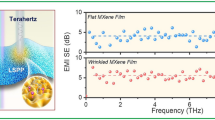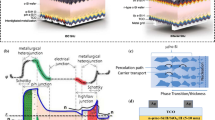Abstract
Transparent electrodes made of silver nanowires (Ag NWs) exhibit a higher flexibility than conventional indium tin oxide electrodes. For this reason, Ag NWs may find applications in future flexible electronic and optoelectronic devices. However, different optoelectronic devices have different specific requirements for Ag NWs. For example, the optical transmittance haze is an important but rarely studied aspect of Ag NW films. In this study, the optical transmittance and optical scattering of long (5–50 μm, L-NWs) and short (1–20 μm, S-NWs) Ag NW films were investigated. The L-NWs exhibited better optical transmission than the S-NWs, whereas the S-NWs exhibited better light-scattering properties than the L-NWs. Our results indicate that the L-NWs are suitable for touch-screen displays, whereas the S-NWs are better suited as transparent conductive films for solar cells. We analyzed the scattering ratio of forward-scattered light to backscattered light for both the L-NWs and S-NWs and discovered that the mesh size affected the scattering ratio. For longer wavelengths, a larger mesh yielded a higher backscattering ratio, whereas a smaller mesh yielded a lower backscattering ratio. We formulated an equation for calculating the reflection haze using the total reflection (Ag NWs/glass), R and the reflection of glass, R 0. The reflection haze of the S-NWs and L-NWs exhibited different trends in the visible–near-infrared region. An omnidirectional scattering model for the Ag NWs was used to evaluate the Ag NW scattering properties. The results of this study have great significance for the evaluation of the performance of Ag NWs in optoelectronic devices.

Similar content being viewed by others
References
Bae, S.; Kim, H.; Lee, Y.; Xu, X. F.; Park, J. S.; Zheng, Y.; Balakrishnan, J.; Lei, T.; Kim, H. R.; Song, Y. et al. Rollto- roll production of 30-inch graphene films for transparent electrodes. Nat. Nanotechnol. 2010, 5, 574–578.
Li, X. S.; Zhu, Y. W.; Cai, W. W.; Borysiak, M.; Han, B. Y.; Chen, D.; Piner, R. D.; Colombo, L.; Ruoff, R. S. Transfer of large-area graphene films for high-performance transparent conductive electrodes. Nano Lett. 2009, 9, 4359–4363.
Minami, T. Transparent conducting oxide semiconductors for transparent electrodes. Semicond. Sci. Technol. 2005, 20, S35–S44.
Hecht, D. S.; Hu, L. B.; Irvin, G. Emerging transparent electrodes based on thin films of carbon nanotubes, graphene, and metallic nanostructures. Adv. Mater. 2011, 23, 1482–1513.
Wang, X.; Zhi, L. J.; Müllen, K. Transparent, conductive graphene electrodes for dye-sensitized solar cells. Nano Lett. 2008, 8, 323–327.
Jansseune, T. Indium price soars as demand for displays continues to grow. Comp. Semicond. 2005, 11, 34–35.
Boehme, M.; Charton, C. Properties of ITO on PET film in dependence on the coating conditions and thermal processing. Surf. Coat. Technol. 2005, 200, 932–935.
Lee, J. Y.; Connor, S. T.; Cui, Y.; Peumans, P. Solutionprocessed metal nanowire mesh transparent electrodes. Nano Lett. 2008, 8, 689–692.
Hu, L. B.; Kim, H. S.; Lee, J. Y.; Peumans, P.; Cui, Y. Scalable coating and properties of transparent, flexible, silver nanowire electrodes. ACS Nano 2010, 4, 2955–2963.
De, S.; Higgins, T. M.; Lyons, P. E.; Doherty, E. M.; Nirmalraj, P. N.; Blau, W. J.; Boland, J. J.; Coleman, J. N. Silver nanowire networks as flexible, transparent, conducting films: Extremely high DC to optical conductivity ratios. ACS Nano 2009, 3, 1767–1774.
Khanarian, G.; Joo, J.; Liu, X. Q.; Eastman, P.; Werner, D.; O'Connell, K.; Trefonas, P. The optical and electrical properties of silver nanowire mesh films. J. Appl. Phys. 2013, 114, 024302.
Jiu, J. T.; Murai, K.; Kim, D.; Kim, K.; Suganuma, K. Preparation of Ag nanorods with high yield by polyol process. Mater. Chem. Phys. 2009, 114, 333–338.
Baughman, R. H.; Zakhidov, A. A.; de Heer, W. A. Carbon nanotubes—The route toward applications. Science 2002, 297, 787–792.
Yakobson, B. I.; Avouris, P. Mechanical properties of carbon nanotubes. In Carbon Nanotubes; Dresselhaus, M. S.; Dresselhaus, G.; Avouris, P., Eds.; Springer: Berlin, Heidelberg, 2001; pp 287–327.
Niu, C. M.; Sichel, E. K.; Hoch, R.; Moy, D.; Tennent, H. High power electrochemical capacitors based on carbon nanotube electrodes. Appl. Phys. Lett. 1997, 70, 1480–1482.
Wu, J. B.; Becerril, H. A.; Bao, Z.; Liu, Z. F.; Chen, Y. S.; Peumans, P. Organic solar cells with solution-processed graphene transparent electrodes. Appl. Phys. Lett. 2008, 92, 263302.
Kim, K. S.; Zhao, Y.; Jang, H.; Lee, S. Y.; Kim, J. M.; Kim, K. S.; Ahn, J. H.; Kim, P.; Choi, J. Y.; Hong, B. H. Largescale pattern growth of graphene films for stretchable transparent electrodes. Nature 2009, 457, 706–710.
Zhang, Q. C.; Tang, L.; Luo, J.; Zhang, J.; Wang, X. N.; Li, D.; Yao, Y. G.; Zhang, Z. X. Direct growth of nanocrystalline graphene/graphite all carbon transparent electrode for graphene glass and photodetectors. Carbon 2017, 111, 1–7.
Gustafsson, G.; Cao, Y.; Treacy, G. M.; Klavetter, F.; Colaneri, N.; Heeger, A. J. Flexible light-emitting diodes made from soluble conducting polymers. Nature 1992, 357, 477–479.
Zou, J. Y.; Yip, H. L.; Hau, S. K.; Jen, A. K. Y. Metal grid/conducting polymer hybrid transparent electrode for inverted polymer solar cells. Appl. Phys. Lett. 2010, 96, 203301.
Kiran Kumar, A. B. V.; Wan Bae, C.; Piao, L. H.; Kim, S. H. Silver nanowire based flexible electrodes with improved properties: High conductivity, transparency, adhesion and low haze. Mater. Res. Bull. 2013, 48, 2944–2949.
Kim, T.; Canlier, A.; Kim, G. H.; Choi, J.; Park, M.; Han, S. M. Electrostatic spray deposition of highly transparent silver nanowire electrode on flexible substrate. ACS Appl. Mater. Interfaces 2013, 5, 788-794.
Langley, D. P.; Giusti, G.; Lagrange, M.; Collins, R.; Jiménez, C.; Bréchet, Y.; Belleta, D. Silver nanowire networks: Physical properties and potential integration in solar cells. Sol. Energ. Mat. Sol. C. 2014, 125, 318–324.
Yu, X. M.; Yu, X.; Zhang, J. J.; Zhang, D. K.; Ni, J.; Cai, H. K.; Zhang D. X.; Zhao, Y. Investigation of light transmission and scattering properties in silver nanowire mesh transparent electrodes. Mater. Lett. 2015, 145, 219–223.
Araki, T.; Jiu, J. T.; Nogi, M.; Koga, H.; Nagao, S.; Sugahara, T.; Suganuma, K. Low haze transparent electrodes and highly conducting air dried films with ultra-long silver nanowires synthesized by one-step polyol method. Nano Res. 2014, 7, 236–245.
Liu, Y.; Chen, Y. Y.; Shi, R.; Cao, L. J.; Wang, Z.; Sun, T.; Lin, J. J.; Liu, J. Q.; Huang, W. High-yield and rapid synthesis of ultrathin silver nanowires for low-haze transparent conductors. RSC Adv. 2017, 7, 4891–4895.
Sorel, S.; Lyons, P. E.; De, S.; Dickerson, J. C.; Coleman, J. N. The dependence of the optoelectrical properties of silver nanowire networks on nanowire length and diameter. Nanotechnology 2012, 23, 185201.
Katagiri, K.; Hunakubo, T. Metal nanowires, method for producing same, transparent conductor and touch panel. U.S. Patent 20120255762 A1, Oct. 11, 2012.
Colin, P.; Xu, Y. L.; Han, X. G.; Munday, J. N.; Hu, L. B. Optical haze of transparent and conductive silver nanowire films. Nano Res. 2013, 6, 461–468.
Jiu, J.; Araki, T.; Wang, J.; Nogi, M.; Sugahara, T.; Nagao, S.; Koga, H.; Suganuma, K.; Nakazawa, E.; Hara, M. et al. Facile synthesis of very-long silver nanowires for transparent electrodes. J. Mater. Chem. A 2014, 2, 6326–6330.
Tokuno, T.; Nogi, M.; Karakawa, M.; Jiu, J. T.; Nge, T. T.; Aso, Y.; Suganuma, K. Fabrication of silver nanowire transparent electrodes at room temperature. Nano Res. 2011, 4, 1215–1222.
Tsai, C.-H.; Hsu, S.-Y.; Huang, T.-W.; Tsai, Y.-T.; Chen, Y.-F.; Yuan, H. J.; Lun, H.; Wu, C.-C.; Chen, Y.-S.; Chen, C.-W. et al. Influences of textures in fluorine-doped tin oxide on characteristics of dye-sensitized solar cells. Org. Electron. 2011, 12, 2003–2011.
Chiba, Y.; Islam, A.; Watanabe, Y.; Komiya, R.; Koide, N.; Han, L. Y. Dye-sensitized solar cells with conversion efficiency of 11.1%. Jpn. J. Appl. Phys. 2006, 45, L638.
Kluth, O.; Rech, B.; Houben, L.; Wieder, S.; Schö pe, G.; Beneking, C.; Wagner, H.; Löffl, A.; Schock, H. W. Texture etched ZnO:Al coated glass substrates for silicon based thin film solar cells. Thin Solid Films 1999, 351, 247–253.
Fang, Z. Q.; Zhu, H. L.; Yuan, Y. B.; Ha, D.; Zhu, S. Z.; Preston, C.; Chen, Q. X.; Li, Y. Y.; Han, X. G.; Lee, S. et al. Novel nanostructured paper with ultrahigh transparency and ultrahigh haze for solar cells. Nano Lett. 2014, 14, 765–773.
Zhang, S. T.; Foldyna, M.; Roussel, H.; Consonni, V.; Pernot, E.; Schmidt-Mende, L.; Rapenne, L.; Jiménez, C.; Deschanvres, J.-L.; Muñoz-Rojas, D. et al. Tuning the properties of F:SnO2 (FTO) nanocomposites with S:TiO2 nanoparticles-promising hazy transparent electrodes for photovoltaics applications. J. Mater. Chem. C 2017, 5, 91–102.
Tao, A.; Kim, F.; Hess, C.; Goldberger, J.; He, R. R.; Sun, Y. G.; Xia, Y. N.; Yang, P. D. Langmuir–Blodgett silver nanowire monolayers for molecular sensing using surfaceenhanced Raman spectroscopy. Nano Lett. 2003, 3, 1229–1233.
Acknowledgements
This work was supported from the National Natural Science Foundation of China (Nos. 11604298 and 61377031) and Scientific Research Foundation (Nos. Q1444 and 1539) of Zhejiang Ocean University.
Author information
Authors and Affiliations
Corresponding author
Electronic supplementary material
Rights and permissions
About this article
Cite this article
Yu, X., Yu, X., Zhang, J. et al. Optical properties of conductive silver-nanowire films with different nanowire lengths. Nano Res. 10, 3706–3714 (2017). https://doi.org/10.1007/s12274-017-1583-6
Received:
Revised:
Accepted:
Published:
Issue Date:
DOI: https://doi.org/10.1007/s12274-017-1583-6




